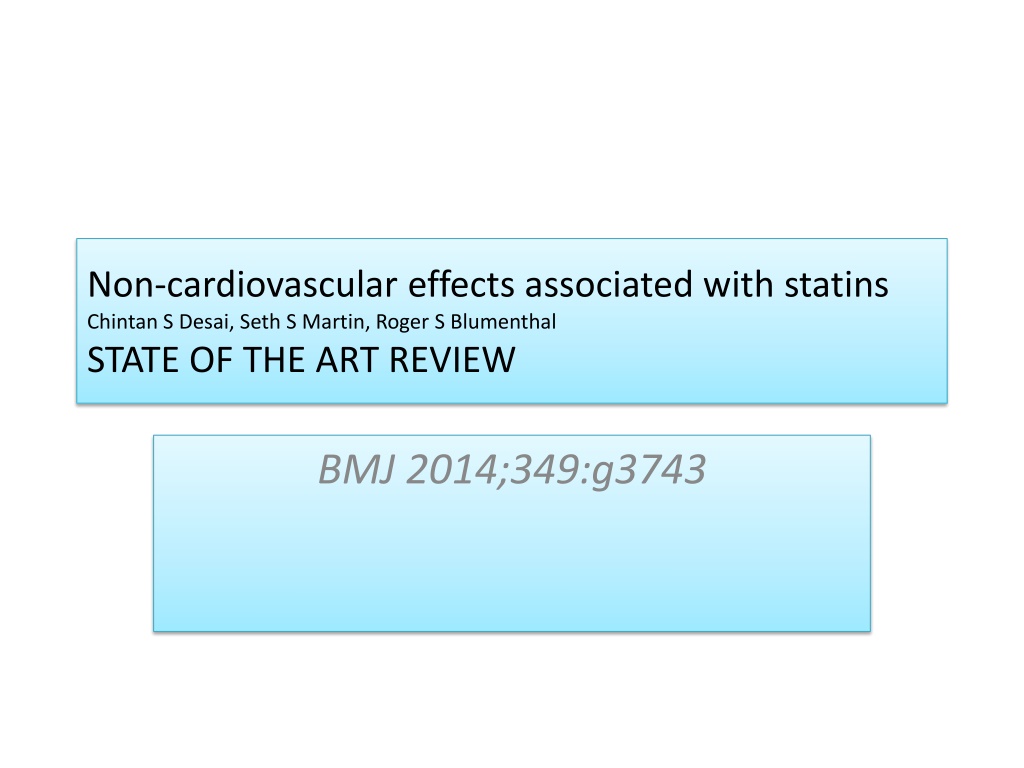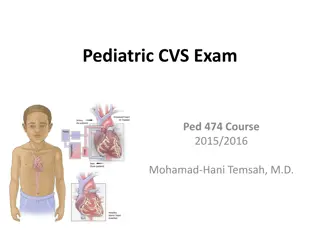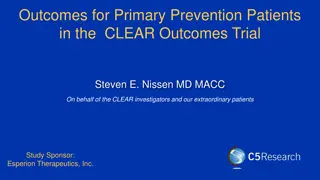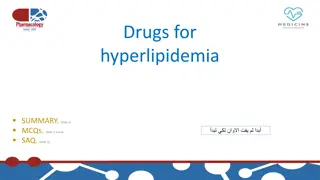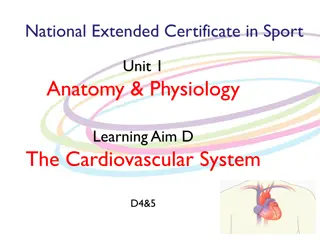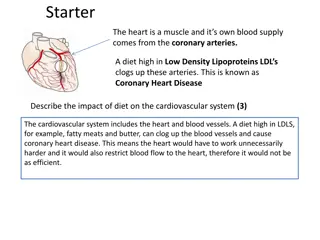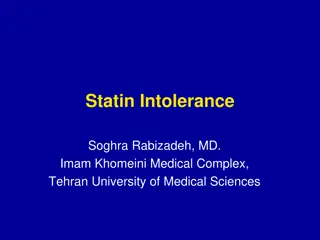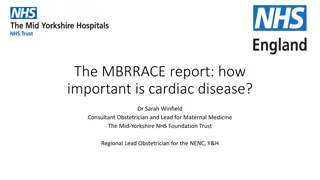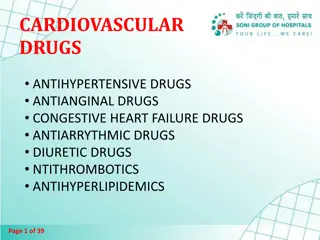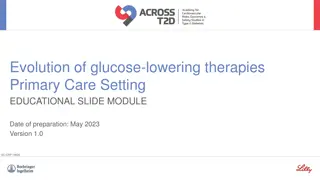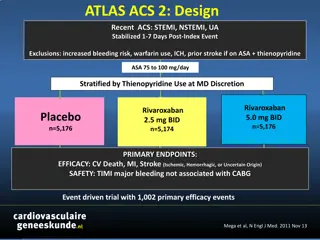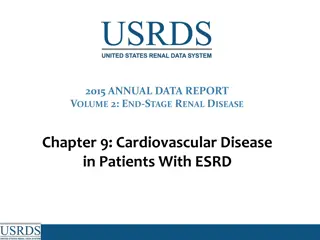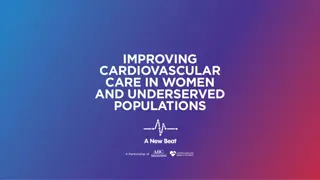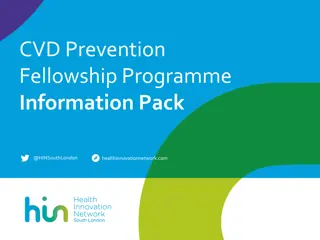Non-Cardiovascular Effects of Statins
Statins, commonly used for preventing cardiovascular disease, are associated with various non-cardiovascular effects. These effects include systemic inflammation reduction, endothelial dysfunction improvement, and platelet hyper-reactivity reduction. While statins offer pleiotropic benefits, they may also pose risks such as myopathy, diabetes, and other non-cardiovascular issues. It's crucial for healthcare providers to weigh these risks against the benefits when prescribing statins for primary prevention. Myalgias have been reported in studies without a confirmed increase in creatine kinase levels.
Download Presentation

Please find below an Image/Link to download the presentation.
The content on the website is provided AS IS for your information and personal use only. It may not be sold, licensed, or shared on other websites without obtaining consent from the author. Download presentation by click this link. If you encounter any issues during the download, it is possible that the publisher has removed the file from their server.
E N D
Presentation Transcript
Non-cardiovascular effects associated with statins Chintan S Desai, Seth S Martin, Roger S Blumenthal STATE OF THE ART REVIEW BMJ 2014;349:g3743
Introduction Statins (3-hydroxy-3-methylglutaryl-coenzyme A reductase inhibitors) form the pharmacologic cornerstone of the primary and secondary prevention of atherosclerotic cardiovascular disease. More than 200 million people worldwide take these drugs, including more than 30 million in the United States.
In randomized controlled trials (RCTs) and meta-analyses of primary and secondary prevention, statins have produced a significant reduction in incident myocardial infarction, stroke, and death from cardiovascular disease in all patients, and all- cause mortality in higher risk patients. As well as lowering low density lipoprotein cholesterol (LDL-C), statins are also thought to have anti-inflammatory and direct effects on plaque, leading to coronary plaque stabilization and even modest regression of atheroma.
When used for primary prevention, statins are generally prescribed to asymptomatic people for a prolonged period of time. Therefore, the risks must be carefully weighed against the benefits. As well as lipid lowering properties,statins are thought to exert additional effects, known as pleiotropic effects. The pleiotropic benefits of statins may be mediated by a reduction in systemic inflammation , endothelial dysfunction, and platelet hyper-reactivity.
Medical Definition of PLEIOTROPIC : producing more than one effect
https://encrypted-tbn3.gstatic.com/images?q=tbn:ANd9GcSIJXbAN4BDdoEGfb97UQlMsoy4WQdKFK0xLJutwTu2CpmuMocfvKdVSAhttps://encrypted-tbn3.gstatic.com/images?q=tbn:ANd9GcSIJXbAN4BDdoEGfb97UQlMsoy4WQdKFK0xLJutwTu2CpmuMocfvKdVSA Conversely, statins could have harmful effects through excessive cholesterol lowering or through other mechanisms. Although statins are well tolerated by most patients, there are widespread concerns about the potential harms associated with their use. Non-cardiovascular harms associated with statins in clinical trials include myopathy and diabetes, and non-cardiovascular benefits include reduced incidence of contrast nephropathy and pancreatitis.
Myalgias without a documented increase in creatine kinase were reported in 21 studies of 48 138 patients. The relative risk of myalgias with statins compared with placebo was 0.99 (0.96 to 1.03). When examined individually, only atorvastatin was associated with a greater incidence of myalgias when compared with placebo (5.1% v 1.6%; relative difference per 1000 patients 31.9, 2.1 to 61.6; P=0.04).
cerivastatin was analyzed separately (four trials, N=total 2282; 1898 randomized to cerivastatin, 384 randomized to placebo). Treatment with cerivastatin compared with placebo resulted in a 12-foldincreased risk of rhabdomyolysis (risk difference 12.4, 5.4 to 19.3; P<0.001). Cerivastatin was withdrawn from the market in 2001 because of the observed increase in rhabdomyolysis.
A third more recent meta-analysis of statin use for primary and secondary prevention also assessed myopathy. Among 14 primary prevention trials (46 262 patients), nine reported myalgias (no increase in creatine kinase) in people taking statins versus placebo. There was no significant difference between the groups (7.9% v 7.6%; absolute risk increase with statins 0.3, 0.2 to 0.8; P=0.41). There was also no significant increase in myositis (0.3% with statins and 0.2% with placebo (0%, 0.1% to 0.1%; P=0.10)) and no increase in rhabdomyolysis (three cases each with statin and placebo; P=0.96).
These meta-analyses of RCT data suggest that statins are associated with a modest increase in the risk of myositis and rhabdomyolysis, but not with myalgia. The risk is largely confined to treatment with high dose statins, particularly simvastatin 80 mg, which is no longer recommended, with the US Food and Drug Administration advising that its use is limited. Statin associated myopathy also occurs at a higher rate in patients who are concurrently prescribed drugs that interact with statins to increase their effective blood level
Simvastatin and atorvastatin: interactions Many important interactions atorvastatin relate to drugs that inhibit or induce metabolism via the cytochrome enzyme, or that affect transport proteins. Starting dose If co-prescription with a drug that increases systemic exposure to statins is unavoidable, it is particularly important to start on the lowest statin dose. for simvastatin and P450 (CYP3A4) For atorvastatin and simvastatin the starting dose is 10 mg daily.
Interacting drug or food Simvastatin prescribing advice Atorvastatin prescribing advice Potent CYP3A4 ketoconazole, erythromycin, clarithromycin, telithromycin, and HIV protease inhibitors All are contraindicated with simvastatin Avoid if possible: consider temporary suspension of atorvastatin if interacting drug is taken for short period Itraconazole: do not exceed 40 mg atorvastatin daily Clarithromycin: do not exceed 20 mg atorvastatin daily HIV protease inhibitors: monitor lipid levels to ensure lowest necessary dose of atorvastatin is used inhibitors, including itraconazole,
Ciclosporin* Do not exceed 10 mg simvastatin daily Do not exceed 10 mg atorvastatin daily Danazol Do not exceed 10 mg simvastatin daily Verapamil, amiodarone Do not exceed 20 mg simvastatin daily Monitor lipid levels to ensure lowest necessary dose of atorvastatin is used Diltiazem Do not exceed 40 mg simvastatin daily Monitor lipid levels to ensure lowest necessary dose of atorvastatin is used
Grapefruit juice Avoid grapefruit juice Warfarin/courmarins Monitor INR before starting treatment and regularly during treatment, especially with dose changes Fibrates Increased risk of myopathy when used with fibrates; do not exceed 10 mg simvastatin daily (except with fenofibrate); gemfibrozil increases systemic exposure to simvastatin Ezetimibe Additive risk of myopathy cannot be ruled out
Re-challenge Recent observational data show that most patients who develop symptoms while taking a statin can be safely restarted on a statin. In a cohort of 1605 consecutive patients referred to the Cleveland Clinic for statin intolerance,1163 (73%) were able to tolerate at least intermittent dosing of a statin for a median of 31 months. Among patients who were able to tolerate statins, 1014 (87%) tolerated daily dosing and the remainder tolerated intermittent dosing. Patients who could tolerate intermittent dosing had a significantly greater reduction in LDL-C compared with intolerant patients (21.3% (standard deviation 4.0%) and 8.3% (2.2%) reduction, respectively; P<0.001). Kaplan-Meier estimates showed that patients who could tolerate any statin dose also had a borderline significant decrease in all-cause mortality (P=0.08). Rosuvastatin was the most commonly tolerated statin in this study.
Similarly, in an observational cohort of 6579 patients whose statin was discontinued because of side effects, 92% of patients could tolerate a statin when re-challenged. In this cohort, 27% of patients whose statin was discontinued had a documented muscle related side effect, yet nearly all of these patients were able to tolerate a re-challenge. The fact that symptoms often do not recur on re-challenge suggests that they are unrelated to the statin
Diabetes Randomized trials have shown a consistent increase in the risk of incident diabetes associated with statin therapy. Although the mechanism underlying this association is unclear, inhibition of HMG-CoA (3-hydroxy-3-methylglutarylcoenzyme) reductase and the resulting reduced expression of insulin sensitive glucose transporter type 4 probably play an important role in impaired glucose metabolism. Experimental data suggest that statins may also reduce pancreatic cell function and promote cell apoptosis, thereby leading to reduced insulin secretion
In the Justification for the Use of Statins in Primary Prevention (JUPITER) study, patients were randomly assigned to rosuvastatin 20 mg daily or placebo. Incident diabetes reported by a physician was a prespecified secondary endpoint in the trial protocol, and all patients with diabetes were excluded from the trial. Over a median of 1.9 years of follow-up, the frequency of incident diabetes was significantly higher with rosuvastatin than with placebo (3.0% v 2.4%, P=0.01; confidence intervals not reported).
A subsequent meta-analysis of 13 statin trials included 91 140 patients without diabetes who were randomly assigned to statin or placebo. Over a mean follow-up of four years (weighted average of trials), significantly more patients taking a statin developed incident diabetes (4.9% v 4.5%; odds ratio 1.09, 1.02 to 1.17; number needed to harm (NNH) 250
A more recent meta-analysis found that the association between statins and incident diabetes is influenced by the dose and potency of statin. The meta-analysis looked at 32 752 patients without baseline diabetes from five statin trials, all of which compared high versus moderate intensity statin therapy. Compared with moderate dose statin treatment, intensive dose statins were associated with a 12% increase in the odds of incident diabetes
? The increased risk of incident diabetes associated with statins seems to be confined mainly to people who are already at high risk of diabetes. In JUPITER, 486 diabetes events occurred during follow-up and 77% of events occurred in patients with impaired fasting glucose before randomization. Furthermore, all of the incident diabetes events occurred in patients who had at least one risk factor for diabetes: impaired fasting glucose, body mass index greater than 30, metabolic syndrome, or glycated hemoglobin greater than 6.0% (42 mmol/mol).
For trial participants with at least one of the four major risk factors, 134 vascular events or deaths were avoided for every 54 diabetes events. Among trial participants with no major risk factors for diabetes, 86 vascular events or deaths were avoided with no diabetes events. Both groups had significant reductions in relative risk for the primary outcome of major vascular events with rosuvastatin 39% in those with at least one diabetes risk factor, 52% in those with no diabetes risk factors.
Liver No cases of liver failure occurred in either meta-analysis of clinical trials. Only 30 cases of statin induced liver failure were reported between 1987 and 2000 in the Western world. one case per million person years of use, similar to that in the overall US population. The rate of liver failure in statin users is estimated at Among patients who experience increases in alanine aminotransferase while on statins, levels tend to normalise despite continuation of treatment, perhaps because of a reduction in hepatic steatosis.
Furthermore, this increase in alanine aminotransferase may represent Adaptation of the liver to the lower serum cholesterol, rather than direct hepatotoxicity. Available data suggest that moderate and high dose statins are associated with modestly increased liver transaminases, but that this increase is asymptomatic and generally reversible.
Cataracts Recently, there has been concern that statins may increase the incidence of cataracts. Statins reduce oxidative stress but may also prevent proper epithelial cell development in the lens, thereby providing a potential mechanism for cataracts. Another possible mechanism is that the lens is a mostly avascular structure that relies on endogenous synthesis to meet its cholesterol demands.
RCT vs OBSERVATIONAL STUDIES Thus, for now, there is no robust evidence from randomized trials that statins increase the incidence of cataracts, although the data are limited.
https://encrypted-tbn0.gstatic.com/images?q=tbn:ANd9GcTom2dAPGtCwk2D3Se76kzSq_fO1sK9uiSUAjM7LwomX4S5wvBIaB9H_whttps://encrypted-tbn0.gstatic.com/images?q=tbn:ANd9GcTom2dAPGtCwk2D3Se76kzSq_fO1sK9uiSUAjM7LwomX4S5wvBIaB9H_w Dementia and cognition In 2012, the FDA added a warning to the statin product label stating that some patients may experience ill-defined memory loss and confusion. This warning was based mainly on small randomized trials and observational data, including case reports. Since then, the fears of cognitive decline associated with statins have been popularized in the media.
https://encrypted-tbn2.gstatic.com/images?q=tbn:ANd9GcQEdrO-VsA_R2OUNZ7JG_ZH-5FNB-EmV8iXArEc-sbsehGZpXOBALVukNwhttps://encrypted-tbn2.gstatic.com/images?q=tbn:ANd9GcQEdrO-VsA_R2OUNZ7JG_ZH-5FNB-EmV8iXArEc-sbsehGZpXOBALVukNw Several potential mechanisms have been proposed to explain the association between statins and cognitive function. Excessive inhibition of cholesterol synthesis may impair the integrity of neuronal cell membranes. Lipophilic statins that cross the blood-brain barrier (such as simvastatin and atorvastatin) may also have direct adverse effects on neurons.
https://encrypted-tbn2.gstatic.com/images?q=tbn:ANd9GcT3WjnB3--4M8r8zerwX-PUNp9SHadzTKGm4F4Un_XA1rOqinVx6IP6wwhttps://encrypted-tbn2.gstatic.com/images?q=tbn:ANd9GcT3WjnB3--4M8r8zerwX-PUNp9SHadzTKGm4F4Un_XA1rOqinVx6IP6ww Conversely, statins may have a beneficial effect on cognition through multiple mechanisms: including improved endothelial function, reduction in free radical formation, and reduction in inflammation. Statins also reduce the incidence of clinical atherosclerotic cardiovascular disease, which is a risk factor for vascular dementia
RCTs have generally reported null effects on dementia and cognition.
!!!!!!! RCTs have generally reported null effects on dementia and cognition. https://encrypted-tbn3.gstatic.com/images?q=tbn:ANd9GcTv94RIOK9VAJ6kJ07gbwcdZ5CAd2wSpWQUjPxWQs8wQBbv66Bzlg4kMkNs
Venous thromboembolism An important pleiotropic effect of statins is a reduction in vascular inflammation and concentrations of thrombotic factors, including C reactive protein and D-dimer. It is unclear whether there is an association between statins and venous thromboembolism
Kidney . Contrast induced nephropathy Acute kidney injury is a common adverse event in patients who are exposed to contrast media, which are commonly used in diagnostic and interventional cardiovascular procedures. The mechanism of contrast induced nephropathy is thought to involve hemodynamic changes in renal blood flow and direct tubular toxicity. It has been proposed that statins reduce incident contrast induced nephropathy through inhibition of the reabsorption of contrast media from the urinary space, thereby limiting the inflammatory, apoptotic, and oxidative effects resulting from contrast exposure.
Meta-analysis of seven trials (1399 patients) reported a significant reduction in the incidence of contrast induced nephropathy in patients taking high dose statins compared with low dose statins or placebo Overall, the incidence of contrast induced nephropathy was reduced by 49% with high dose statins (relative risk 0.51,0.34 to 0.76).
More recent RCTs have shown that even a single high dose of a statin reduces the incidence of contrast induced nephropathy. The Novel Approaches for Preventing or Limiting Events (NAPLES) II study randomly assigned patients with chronic kidney disease undergoing elective coronary angiography to a single high dose of atorvastatin 80 mg (202 patients) or placebo (208 patients). Contrast induced nephropathy occurred in 4.5% of patients in the atorvastatin group and 18% of the placebo group (odds ratio 0.22, 0.07 to 0.69; P=0.005). The effect was not modified by diabetes status or severity of chronic kidney disease.
A more recent trialthe Protective Effect of Rosuvastatin and Antiplatelet Therapy on Contrast-Induced Acute Kidney Injury in patients with acute coronary syndromes (PRATOACS) TriaL randomly assigned 504 patients with acute coronary syndrome who were undergoing early invasive coronary angiography to rosuvastatin or placebo. The incidence of contrast induced nephropathy was 6.7% in the rosuvastatin group and 15.1% and placebo group, (odds ratio 0.38, 0.20 to 0.71, P=0.003).
Pancreatitis A reduction in the cholesterol content of bile, with a resulting decreased risk of gallstones, is proposed as a potential mechanism for the effect of statins on the risk of acute pancreatitis. A meta-analysis of published and unpublished clinical trials investigated the risk of pancreatitis in patients allocated to statins versus placebo. In 16 placebo controlled trials of 113 800 patients followed over a weighted mean follow-up of 4.1 years, 134 people taking statins and 175 people taking placebo developed pancreatitis (relative risk 0.77, 0.62 to 0.97) and a number needed to treat of 1175 over five years.
Erectile dysfunction Several studies have investigated the association between statins and erectile dysfunction, with the hypothesis that statins improve erectile function through beneficial effects on the endothelium and increased availability of nitric oxide. In animal models, administration of atorvastatin is associated with improved erection through modulation of penile RhoA-Rho kinase, a pathway that is particularly important in patients with diabetes. There is a concern, however, that statins could theoretically worsen erectile function in some men through decreased synthesis of testosterone. There are no definitive conclusion about the effect of statins for erectile dysfunction and further research is needed.
Chronic obstructive pulmonary disease (COPD) Inflammation is an important component of the pathophysiology of COPD and it is hypothesized that statins may improve outcomes in COPD and resulting secondary pulmonary hypertension through a reduction in neutrophil numbers, T cell activation, and synthesis of endothelin 1. Not enough evidence
Cancer Although individual RCTs have reported an excess incidence of gastrointestinal cancer and breast cancer with statin therapy, The CTT analyzed the risk of cancer in 27 RCTs of statins. Among 67 258 patients allocated to statin and 67 279 patients allocated to placebo for a median of five years, the incidence of any cancer was 1.4% per year in both groups (relative risk 1.00, 0.96 to 1.05). Cancer mortality was 0.5% in both groups and no effect was seen at higher doses of statins. There was also no difference between the groups at 23 individual sites or when cancer was considered in total. These data from a large, individual patient meta-analysis of randomized trials suggests that statins do not cause an excess risk of cancer.
Fatigue JUPITER is currently the largest RCT to have assessed the effect of statins on fatigue (n=17 802). The rate of fatigue was nearly identical in patients treated with placebo or rosuvastatin 1.7/100 person years for placebo v 1.8/100 person years for patients with on-treatment Similarly, the Oxford Cholesterol Study Group found no significant difference in the report of fatigue in a 152 week RCT of 621 participants allocated to simvastatin 20-40 mg daily versus placebo.
Balance of benefits and harms Recent US cholesterol treatment guidelines may increase the number of adults eligible for statin treatment by as many as 13 million. The new guidelines are based on data from multiple large RCTs and meta-analyses that show significant and consistent reductions in cardiovascular events and all cause mortality with statin use in nearly all populations. In the CTT meta-analysis of 22 trials and 134 537 patients, all patients allocated to statins -experienced a 21% relative risk reduction per 1.0 mmol/L of LDL-C lowering, regardless of baseline LDL-C and at all levels of cardiovascular risk. On the basis of those data and our review of the non- cardiovascular effects of statins, for most patients, the benefits of statins far outweigh the harms.
